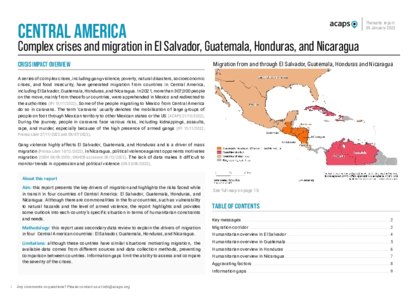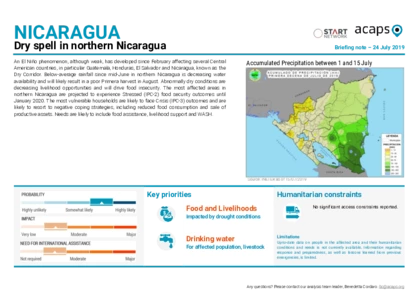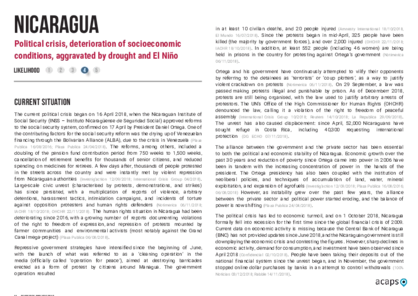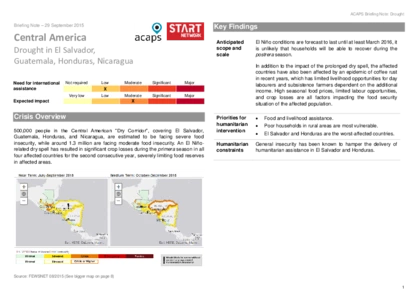Latest updates on country situation
03 September 2024
On 19 August 2024, the Nicaraguan Government shut down over 1,500 NGOs as it escalated its crackdown on civil organisations. This marks a record number of closures, with authorities targeting trade associations, rural groups, the Nicaraguan Red Cross, and numerous faith-based organisations, bringing the total number of closures to over 5,000 between 2018 and mid-2024. These closures have restricted citizens' rights to free association and speech, besides limiting access to the healthcare and protection services previously provided by some of these organisations. (ICG accessed 03/09/2024, DW 19/08/2024, OHCHR accessed 03/09/2024)
Analysis products
on
Nicaragua
05 January 2023
Central America: Complex crises and migration
DOCUMENT / PDF / 1 MB
This report presents the key drivers of migration and highlights the risks faced while in transit in four countries of Central America: El Salvador, Guatemala, Honduras, and Nicaragua. Although there are commonalities in the four countries, the report highlights and provides some outlook into each country’s specific situation in terms of humanitarian constraints and needs.
Attached resources
11 November 2020
Honduras and Nicaragua: Hurricane Eta
DOCUMENT / PDF / 330 KB
On Tuesday 3 November, Hurricane Eta made landfall on the North Atlantic coast of Nicaragua. As the hurricane moved further inland and was downgraded to a tropical storm, it exposed Honduras and other Central American countries to heavy rains that have resulted in widespread flooding and deadly landslides.
24 July 2019
Nicaragua: Dry spell in the north
DOCUMENT / PDF / 502 KB
An El Niño phenomenon, although weak, has developed since February affecting several Central American countries, in particular Guatemala, Honduras, El Salvador and Nicaragua, known as the Dry Corridor. The most vulnerable households are likely to face Crisis (IPC-3) outcomes and are likely to resort to negative coping strategies, including reduced food consumption and sale of productive assets. Needs are likely to include food assistance, livelihood support and WASH.
18 December 2018
Nicaragua: Political and socioeconomic deterioration
DOCUMENT / PDF / 194 KB
Protests against the reform of the social security system that began in April 2018 were instantly met by violent repression from Nicaraguan authorities, prompting a period of large-scale civil unrest characterised by protests, demonstrations, and strikes. Reports of violence, arbitrary detentions, harassment tactics, intimidation campaigns, and incidents of torture against opposition protesters and human rights defenders have increased and are likely to continue.
18 March 2016
Central America: Drought in El Salvador, Guatemala, Honduras, Nicaragua
DOCUMENT / PDF / 626 KB
500,000 people in the Central American “Dry Corridor”, covering El Salvador, Guatemala, Honduras, and Nicaragua, are estimated to be facing severe food insecurity, while around 1.3 million are facing moderate food insecurity. An El Niñorelated dry spell has resulted in significant crop losses during the primera season in all four affected countries for the second consecutive year, severely limiting food reserves in affected areas.






